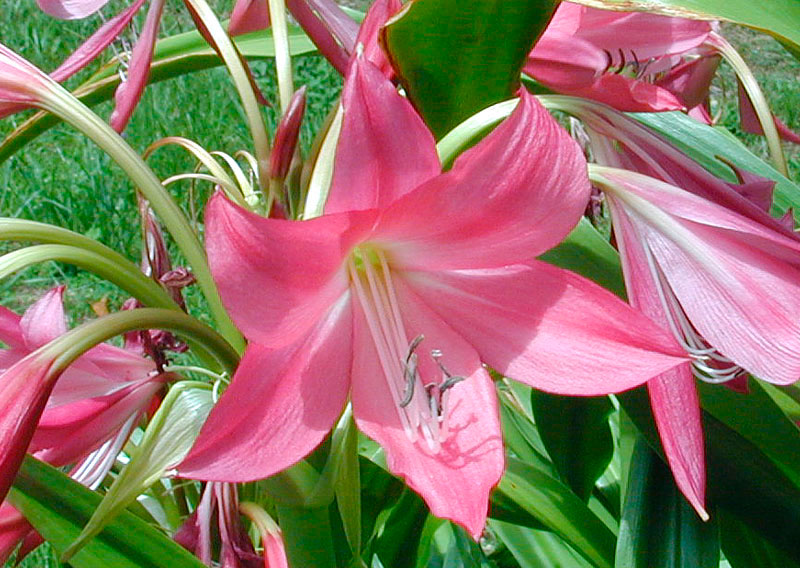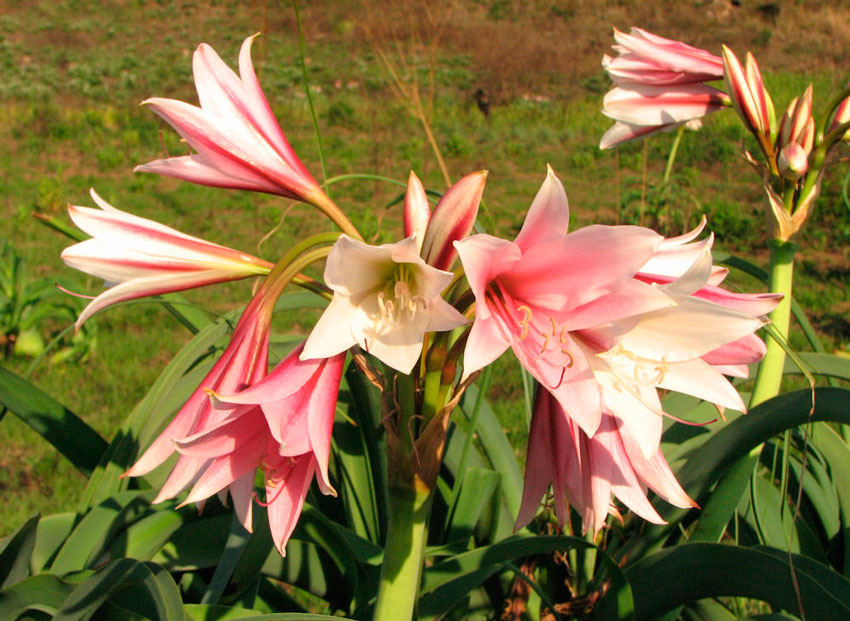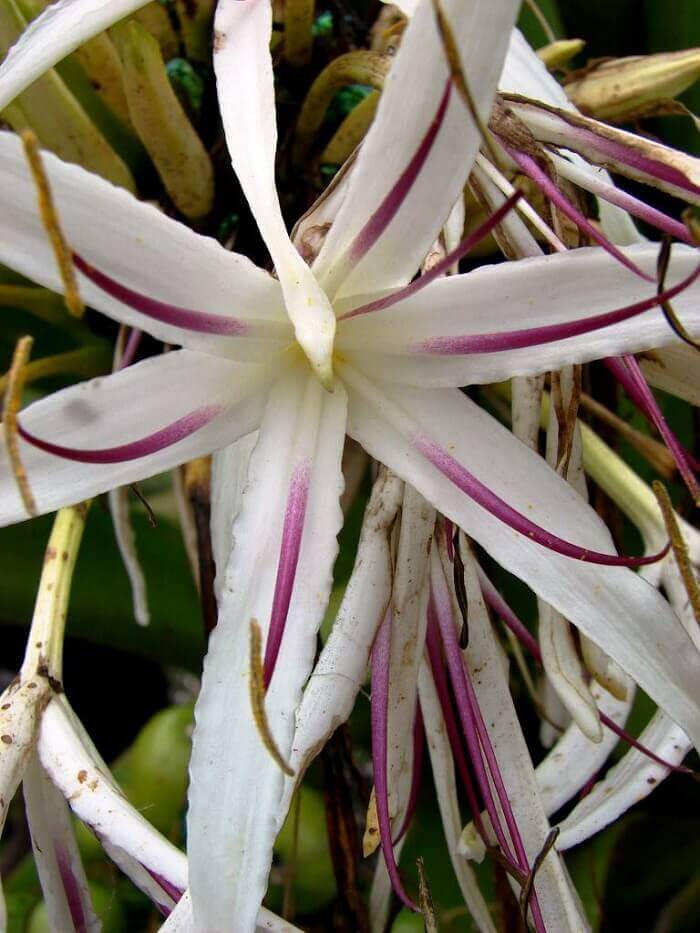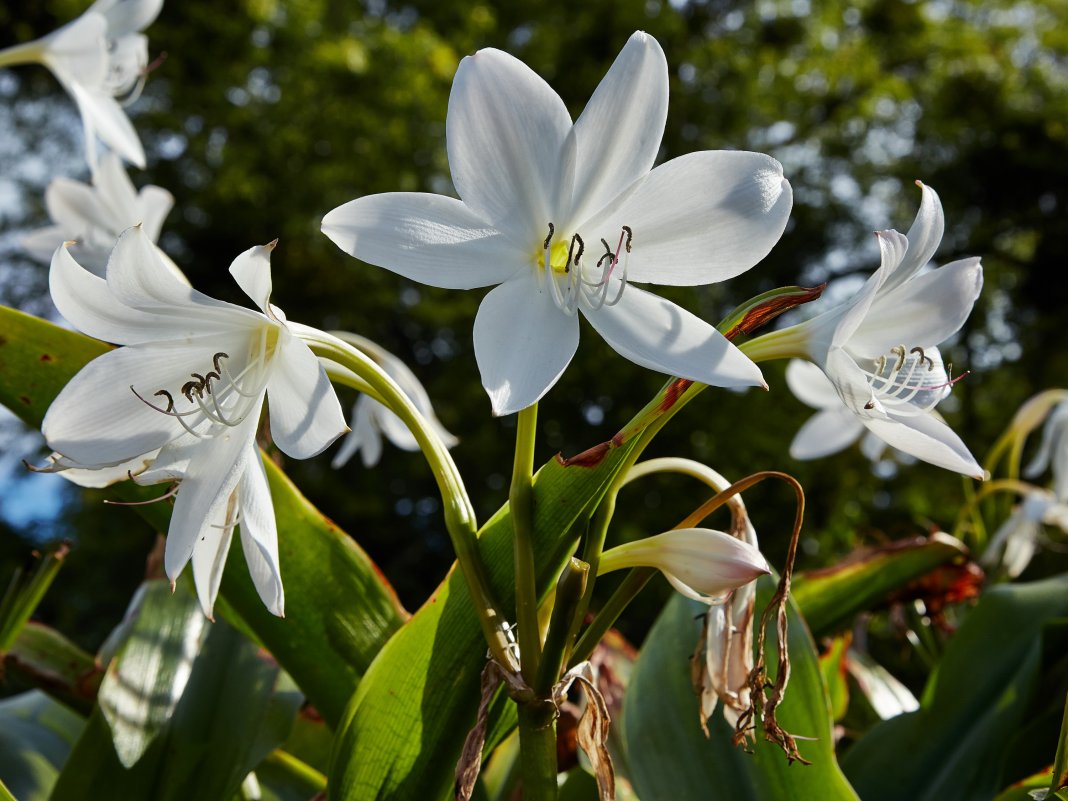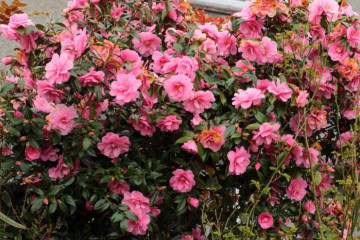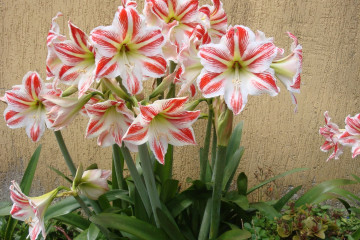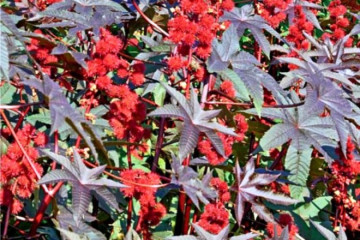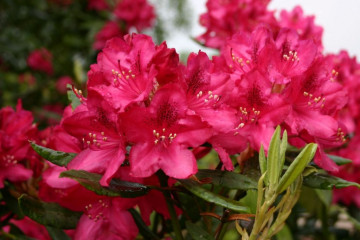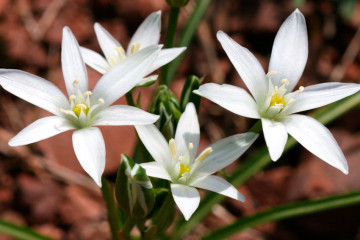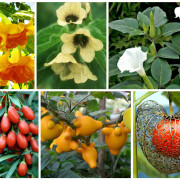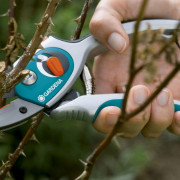Krinum - garden flower, planting and care in the open field
Content:
Krinum is a bulbous plant. Crinum belongs to the Amaryllis family. In its natural environment, it is found in tropical and subtropical climates. Prefers to grow on the seashore, lakes, river floodplains. The plant has a wide variety of subspecies. Crinum flower is often grown by gardeners on their own plots. It can be found in landscaping decoration in combination with shrubs and other flowers. It is also grown as a houseplant.
Popular varieties of crinum flower
All subspecies of krinum have a similar appearance. They differ during the flowering period, some structural features, the color of buds and flowers. From the Latin language, the name of the plant is translated as hair. This is due to the long, elongated foliage, which reaches about 150 cm in height.
The leaves are green, slightly flattened and rolled into thin tubes. The bulbs are large, up to 25 cm in diameter and 90 cm in length. Thin peduncles with pink or white flowers in the form of an umbrella extend from the root.
Wavy krinum
Refers to aquatic species. The plant lives entirely in water. It has an underdeveloped bulb, its diameter is only 3 cm. The leaves are long, elongated, dark green in color. They have waviness along the edges, hence the name - wavy crinum. This variety is often used for aquariums.
Crinum Moore
It is a bulbous plant. Krinum Mura forms leaves 60-90 cm long, up to 10 cm wide, a bulb with a diameter of 20 cm. Many children leave it, which can subsequently be propagated. Flowering occurs in the form of a peduncle with 12-15 pink flowers in the form of umbrellas. This period falls in summer time.
Crinum Powell
Powell's Crinum variety was bred by crossing two other varieties. The plant has long, elongated lanceolate leaves, up to 70 cm long. The bulb is 20 cm in diameter. Peduncles are glabrous, without foliage, growing above the shoots. The color of the flowers is bright, saturated pink. Stamens extend from the center.
Krinum Kalamistratum
This is an aquarium subspecies of wavy krinum, or Calamistratum. It is kept in an aquatic environment, the bulb is poorly developed, has a diameter of only 4-5 cm, the warp goes 3-4 cm deep. The leaves are long, up to 50 cm, thin, dark green, have a characteristic cut along the edge.
Asian crinum
Asiatic krinum is found in the wild on the banks of stagnant reservoirs of Western tropical Africa. The height of the leaves is 120 cm, the bulb is 15 cm in diameter. Its base is 20-25 cm. Peduncles are thin, long, green. Umbrella inflorescence is located at the top. It consists of 15-20 white flowers on a 3-4 cm stalk.
Crinum American
A tall bulbous plant, reaches no more than 1.5 m in height. All parts of the American krinum are poisonous. The bulb is large - 25-30 cm in diameter, the base goes into the ground to a depth of 50 cm. The leaves are straight, elongated, dark green.
Peduncles are tall, naked, green, forming umbrellas with 12-15 small flowers, painted in light pink or hot pink. Crinum flower can be propagated using daughter bulbs.
Floating krinum
Aquatic, suitable for keeping in an aquarium.The floating krinum is very similar to the wavy appearance. In the natural environment, the length of the leaves reaches 1 m, their width is 5 cm. In a confined space, the length of the foliage is much shorter. They have a wavy border and are colored green. They are attached to the substrate with roots and a bulb, which is half sprinkled with soil. In early summer, krinum forms white or pink flowers above the surface of the water.
Outdoor planting recommendations
Krinum garden flower is intended for outdoor use. Before planting, you need to study the features of the plant, its preferences. To grow a crop, you need to create optimal growing conditions:
- The flower is tropical and moisture-loving. Therefore, the place is chosen well-lit, without a draft.
- For the soil, river silt and sand are used. This is the best mixture for krinum. In dry soil, the plant does not grow well.
- In the south, the plant can be left to winter in the open field, in the north and the middle lane, it is recommended to transplant the flower into a pot.
- Crinium bulbous in the open field takes root from the end of April. Previously, it cannot be planted.
- It is recommended to prepare a seedling in a pot in advance, only then transplant.
The procedure for planting krinum in open ground is carried out according to a certain algorithm:
- dig a hole 70 cm deep, 50 cm in diameter;
- add mineral fertilizers and compost to it;
- the flower bulb is placed in a hole and they begin to bury it in layers;
- 1/3 of the onion is left above the ground;
- water the krinum abundantly.
If you prepare a seedling at home, then the container, soil composition and onion are selected in advance. They plant it in a pot in early March. By the time of planting, the plant will give leaves and the first flower stalks. You can transplant a flower only when the soil warms up to 10 ° C.
Rules for caring for crinum in the open field
Crinuma garden planting and outdoor care have their own characteristics. It is necessary to monitor watering, humidity, feed, organize the wintering of the plant, you also need to monitor the health of the flower and protect it from insect attacks and infections.
Wintering plants
Crinum is capable of wintering only in the southern regions. Even there, it is recommended to cover it with insulation and mulch the root area. If we are talking about the north and the Middle Lane, then the flower is transplanted into a pot for the winter. Until the onset of the new season, the plant is kept indoors.
The krinum has a dormant period in winter. At this time, he requires a certain amount of care. It consists in the following manipulations:
- the plant is dug up and cut off;
- transferred to a dark, cool place with a temperature not lower than + 5 ° С;
- watering is completely stopped;
- the bulbs are sprinkled with sawdust or planted in the soil.
Get flowers from a cool place in early March. Krinum will have time to get stronger in 1.5 months and prepare for flowering in the new season.
Watering and moisture
Crinium bulbous when grown in the garden requires regular watering. The soil is irrigated every time the top layer dries up. Do not overfill the flower - this will provoke the development of fungal diseases.
Before watering, check the topsoil by touch. If it is wet, then the procedure is transferred the next time, if, on the contrary, it is dry, then it is watered. The flower has separate requirements for water. It should be warm, settled in advance.
Air humidity is not as important as irrigation. Krinum feels good at any level of moisture in the atmosphere. However, in arid regions, it is worth periodically spraying the flower with water from a spray bottle.
Soil selection and fertilization, top dressing
So that the krinum flower does not keep itself waiting for a long time, you need to choose a suitable soil composition. The plant is used to growing in the tropics on the shores of reservoirs and seas, therefore the best composition for it is silt and river sand. If it is not possible to get the components, then mix:
- peat;
- humus;
- sand;
- clay.
They choose mineral and organic fertilizers. Top dressing is carried out every 2 weeks from the moment the first leaf appears and until the last flower dries completely. Krinum responds well to:
- a mixture of superphosphate and potassium salt;
- liquid solution of chicken manure;
- mullein solution;
- humus mulching.
Frequent problems with pests and diseases
The most common problems for krinum are insects that feed on foliage and infections that disrupt vital processes. Of the diseases most often manifested:
- gray rot;
- anthractosis;
- staganospore.
Diseases appear due to high humidity and decreased immunity. If uncharacteristic spots of gray, black, brown or white colors appear on the leaves, flowers and bulb, then treatment should be carried out. For this purpose, a 2% solution of foundationol or another fungicide for flowering crops is used.
Of insects, they love to feast on krinum leaves:
- mealybug;
- spider mite;
- shield;
- aphids;
- thrips.
Pest infestation is easy to spot. Holes appear in the areas of the plant, insects are visible, there are cobwebs and plaques that are erased with a finger. In this case, the flower is sprayed with an insecticide for flowering crops.
Krinum is a tropical plant that surprises with its beauty. It can often be found in landscaping and home interiors. The flower is not very whimsical to care for. It makes it possible to grow yourself in any climatic zone. However, for the winter, it is better to transplant krinum into a pot. Some of its species decorate the aquariums of fish lovers. Taking care of them will not be a hassle.

